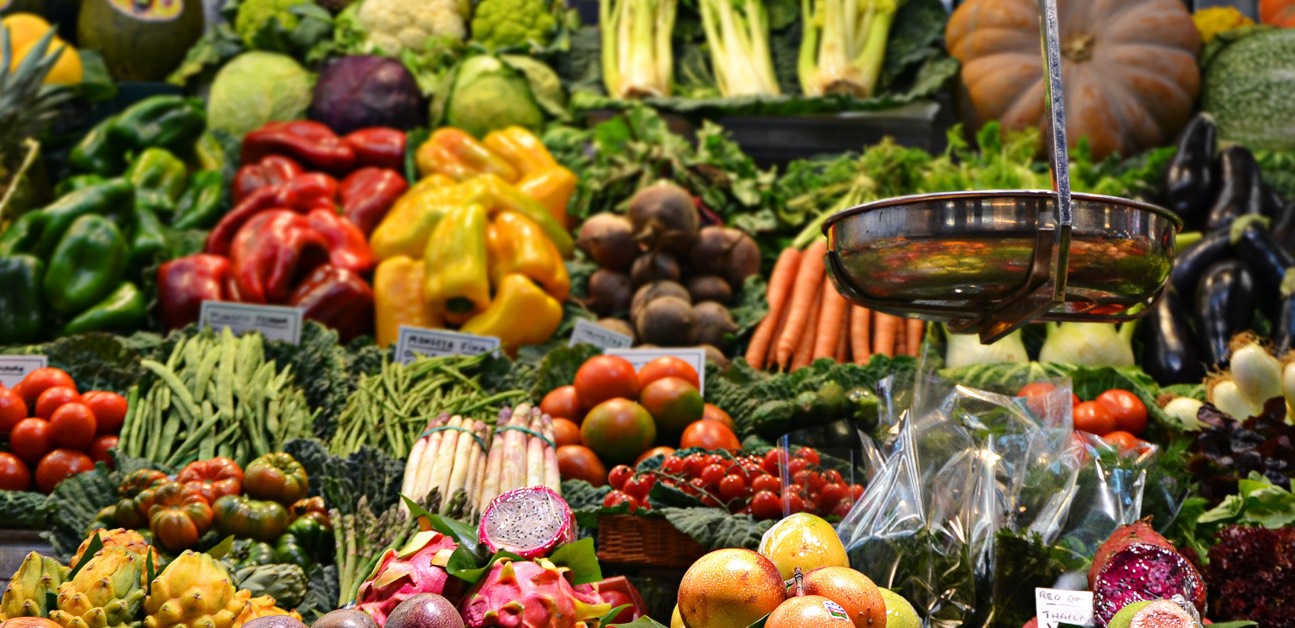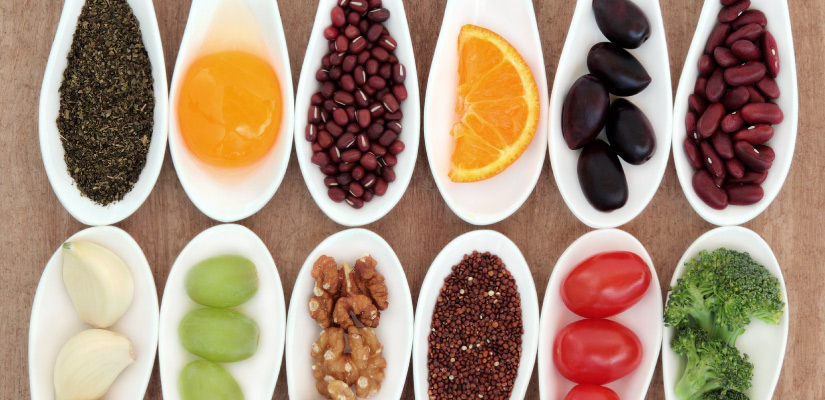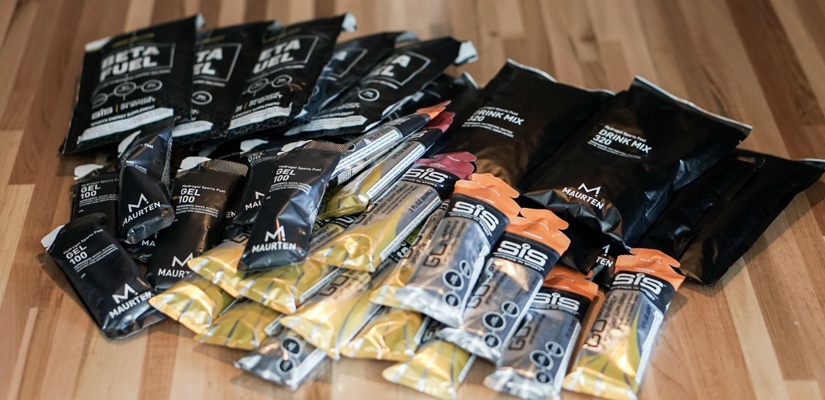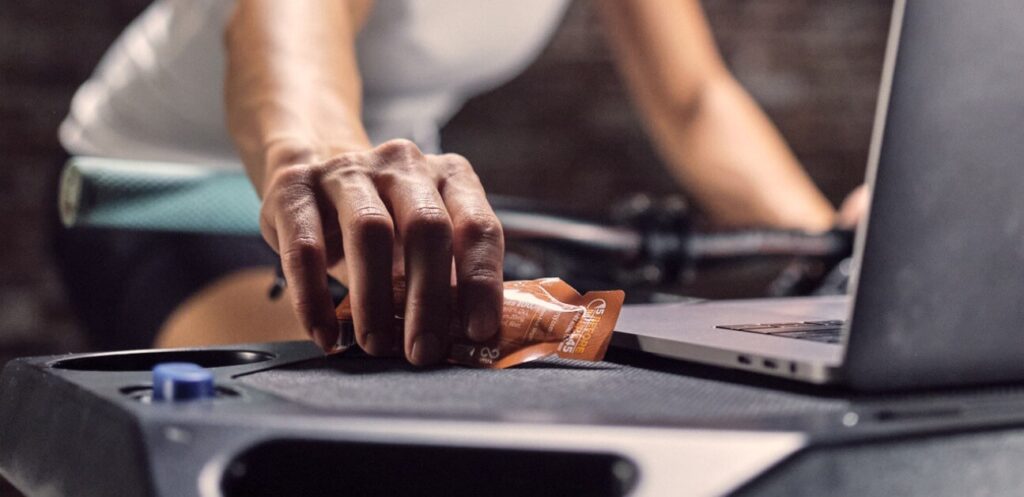Cycling Nutrition: Everything You Need To Know

Nailing your cycling nutrition is one of the easiest ways to improve your performance. Often overlooked but rarely unimportant, it can be complicated and confusing. For peak endurance performance, you’ll need sufficient fuel and hydration, not only for training but for your events as well. This guide will help you with everything you need to know about cycling nutrition.
Basic Principles of Cycling Nutrition
Nutrition can seem complicated and confusing because it’s highly individualized. What works for one person may not work best for you. To help, let’s think about basic principles instead of a long list of rules. Three of the most important are carbs, quantity, and quality.
Calories per day
How many calories you need each day is highly individual and starts with your resting metabolic rate (RMR). RMR is the number of calories when your body is at rest for 24 hours. Essentially, it’s the baseline of your energy expenditure.
Adaptive Training
Get the right workout, every time with training that adapts to you.
Check Out TrainerRoadRMR isn’t a static number and does fluctuate over time. It’s influenced by age, sex, and lean body mass. In general, you can use your RMR and activity level to get an estimate of your daily calorie expenditure using an online calculator.
But what about your activities and training? You can estimate your daily activities, but calculating calories is relatively straightforward with cycling training. You can monitor the number of kilojoules (kJs) expended during a ride or workout with a power meter. Since a kJ is roughly equivalent to a calorie, you can quickly get a close estimate of your cycling calorie burn.
While your calories per day will fluctuate, you can get a good idea of your cycling nutrition needs by adding your RMR and activity calories together. Of course, this isn’t exact, but you can go a step further and track your weight and how you are feeling to ensure you’re getting enough nutrition.
Macros for Cyclists
Now that you know how many calories you need, it’s time to determine what foods are most beneficial to get there. Macronutrients categorize nutrition into three groups—carbohydrates, proteins, and fats. Each one is important for cycling nutrition and general health.
It’s helpful to think about macronutrients as a lever for optimizing your diet for cycling performance. On one end, you have fats, and on the other, you have carbs. The fulcrum rests on protein, so the first step is determining how much protein you need. That is between 1.2-1.4 grams of protein per kilogram of body weight daily for endurance athletes. Then prioritize carbohydrates at 6-10g per kilogram of body weight because it’s the body’s preferred fuel source when performance matters. The fat content will be the calories you have leftover.
If you are trying to lose weight, your macros will be slightly different with an even greater protein intake. For more information, check out Cycling For Weight Loss.
Carbs
It is hard to overstate the importance of carbs for cycling performance. Mitochondria use this simple sugar in your cells to produce ATP, the energy source for all activity. All forms of carbohydrates you ingest are eventually converted to glucose. When your body has more glucose than it needs, it is converted to glycogen and stored in the muscles and liver.
When glycogen stores are full, the liver converts the glucose to triglycerides, which go to fat storage. The good news is that you can increase the glycogen in your muscles can store through training. Peak endurance performance is all about managing these energy stores, highlighting the importance of the amount and timing of your cycling nutrition.
Protein
Protein is another essential macro that’s vital for cycling. Typically, we think of protein as the building blocks of muscle tissue, and rightly so. Protein makes up most of the tissues in the body, including bone, connective tissues, skin, and hair. It also serves as the material for enzymes, hormones, and hemoglobin.
The general recommendation is to consume 0.8 grams of protein per kilogram of body weight every day for most people. However, endurance athletes place a tremendous strain on the body. Researchers recommend consuming 1.2-1.4g per kg. Some studies suggest that upwards of 1.8g per kg is even better.
Fat
Fat usually gets a bad wrap because it’s about twice as calorie-dense as carbs and proteins. However, fats help you absorb vitamins, produce hormones, and create fatty acids that your body doesn’t make itself. Three types of fats are unsaturated, trans, and saturated. Of these three, unsaturated fats like olive or canola oil are generally considered the healthiest option. Because they can cause stomach distress, you probably want to avoid fatty foods during training, but that’s doesn’t mean you need to avoid them totally in your cycling nutrition plan.
What Nutrition is Beneficial for Cyclists?
Heading to the grocery store can lead to a bevy of food choices, often leaving you with a myriad of options and heaps of confusion. It’s helpful to remember two basic principles—quality and quantity. Shopping for quality means that you’re getting nutrient-dense foods and ones that will help you hit your macronutrient goals. Quantity means you’re getting enough for your caloric needs.

However, a balance of quality and quantity can be challenging to achieve. Nutrient-dense foods often contain fewer calories, meaning you’ll need to consume much more for your cycling nutrition needs. For example, a massive bowl of salad, chicken, and vegetables will leave you stuffed but may only have about 600 calories.
Suggested Shopping List
Carbs
- Vegetables like potatoes, broccoli, beans, or peas
- Fruits including bananas, oranges, blueberries, and apples
- Grains like oats, quinoa, rice, and pasta
Protein
- Lean protein like chicken, turkey, yogurt, and eggs
- Plant-based protein including tofu, black beans, chickpeas, or edamame
Fat
- Avocado, Nuts, and seeds
- salmon or tuna
- olive oil
What Should I Eat While Cycling?
Simply put, you need carbohydrates that can be quickly consumed and digested. But, your cycling nutrition will vary based on the weather, power output, duration, intensity, and individual preferences.
What you eat and when you eat it can greatly impact your performance. Fueling before, during, and after will not only increase performance but will improve the consistency of your training. Cycling nutrition can seem overly complicated at times, but we’ll walk through how to figure you how much, what, and when you’ll need to eat.
How Many Calories?
The first step is determining how many carbs and calories you should consume. The answer depends on several factors, but a good starting point is to look at the amount of kJs you’ll expend on the ride. You can discover this number by creating a pacing plan or looking at the workout description. Imagine that you’re completing a three-hour ride workout, and from the pacing plan, you estimate that you’ll burn 1,400 kJs or calories.

How Many Carbs?
Generally, a good starting point for how many carbs to consume in an hour is 60-90 grams. During a ride, the rate you absorb carbs depends on the intensity—the more intense the work, the slower the absorption. Simple sugars, like glucose and fructose, are taken up in about 15-20 minutes.
Most cycling nutrition products use some ratio of glucose and fructose. This is because your body uses different metabolic pathways for these two simple sugars—resulting in faster uptake. Glucose is sent directly to the bloodstream, while the liver metabolizes and converts fructose to glucose. For a long time, the gold standard was 60-90g of carbs per hour using a 2:1 glucose to fructose ratio. Research is emerging that using a 1:1 ratio could increase absorption to upwards of 140g/hr.
That said, what to eat while cycling can vary significantly between athletes and is something that you can experiment with and improve during your training. It’s a delicate balance determining how many carbs you can consume. Too many carbs than you can handle will lead to GI distress, excessive gas, and diarrhea. Your tolerance for carbs during exercise is highly unique, but it’s trainable. Increasing your carb intake to 100g per hour takes time, so practice and take notes.
What to Eat on a Ride
Once you know the number of calories (or kJs), you can figure out what you’re going to eat so that you’re close to an energy balance at the end of the ride. As a general rule, higher intensity rides need quicker acting nutrients. For a high-intensity ride, that means simple sugars like gels and drink mix. For lower-intensity rides, you can get away with eating different foods that contain more complex carbohydrates.
At some point, that intensity and duration of a ride will make it impossible to consume enough calories to finish with an energy balance. This is when pre- and post-ride cycling nutrition will be even more critical.
What to Eat for Long Distance Cycling
Long rides require lots of nutrition, and it all starts with a plan. A practical starting point is 60-90g of carbs per hour for rides lasting longer than an hour. Cycling nutrition products are excellent because they are designed to deliver easily digestible carbs. However, you don’t need to take all those carbs at one time. Instead, try to spread the carbs out over the whole hour, taking some every 15 to 30 minutes.
Key Nutrition Questions for a Long Event
- How much do you need to consume?
- What foods are you going to eat?
- When are you going to eat?
- What are you going to drink?
Fueling a short ride
For workouts and rides lasting sixty minutes or less, you can likely get away with a bottle of water with no extra fuel and still do well. That’s assuming that you’ve fueled adequately beforehand and that you will get enough nutrition afterward. But just because you can, doesn’t always mean you should. Even for short workouts, proper fueling can set you up for long-term success.
Cycling nutrition for a short ride can be as simple as a bottle of drink mix or a water bottle and a couple of gels. Of course, you can easily get enough energy from fueling before or after, but there are benefits to fueling on the bike.
Even for short rides, fueling goes a long way. First, proper cycling nutrition will help preserve the quality of your workout, especially when it’s an intense one. Not only that, but fueling will significantly reduce the margin of error for rides in the days that follow by ensuring that your glycogen stores are as full as possible. It’s helping to think of shorter rides and workouts as training sessions for longer ones. Fueling short rides will build solid nutritional habits that you’ll carry over into multi-hour events.
What to Eat Before Cycling
Before you get on your bike, you’ll want to try your best to fuel up. The goal is to ensure sufficient glycogen stores are in the liver and muscles for the work you will do. Fortunately, it’s easier to fully stock your glycogen stores if you’re eating long before your event by eating regular meals.
Aside from fueling your ride, multiple benefits stem from eating hours, if not days, beforehand. There is less chance of GI distress because you are consuming the carbs incrementally. That is, you are getting them the usual way, with conventional foods. By utilizing regular meals to top off glycogen stores, you can emphasize other nutritional content like minerals and vitamins.
Before your ride, carbohydrate absorption is primarily reliant on your level of glycogen depletion, rate of ingestion, and the type of carb. The lower your glycogen stores, the faster carbs will be absorbed. The type of carb matters too. The more complex the carbohydrate, the longer it takes to digest and absorb. Whole grains and fiber-filled foods can take a couple of hours. Fruit and vegetable absorption times are mostly dependent on fiber content. More fiber means longer times, but 20-40 minutes is usually sufficient for fruits.
It’s important to remember that ingesting protein and fat will lengthen this timeline. A good rule of thumb leading into an event is to eat a carb-centric meal 3-4 hours beforehand. This gives your body ample time to digest. The time frame can be shorter if your meal is principally simple carbs.
You can make your cycling nutrition plan as simple or complicated for your tastes as you’d like. What works for someone else may not work for you. For some, that means only consuming a bottle of high-carb drink per hour, while for others, it’s a mix of bars, gels, fruit, and water. Remember that weather conditions can affect how you feel and your hydration needs.
Once you’ve settled on a nutrition plan, you can set an alarm on your phone or head unit to remind you when to eat. Even though you can schedule eating, don’t forget to listen to your body. Conversely, fueling solely by feel can leave you under-fueled.
Example Cycling Nutrition Plan
Below is an example nutrition plan for a cyclist who will complete a hard, four-hour group ride or race. The pace will vary from endurance to sprinting and everything in between. Each section lists the timing and a few options to provide some variety. For example, you only want to select one of the bullet points.
Pre-Ride Options
Four hours before the ride:
- One large bowl of oatmeal, two tablespoons of honey, and one sliced banana
- Three pancakes, three tablespoons of maple syrup, and a half cup of strawberries
- Two pieces of toast, one egg, a banana, and a cup of orange juice
During Ride Nutrition Options
Aiming for 60-90g of carbs per hour:
- One bottle of Skratch Hydration Mix (21g) and three Science in Sport Go Isotonic Energy Gels (66g) for a total of 87g of carbs
- One bottle of Precision Hydration PH 500 (18g) and one package of Clif Bloks (48g) for a total of 66g of carbs
- One bottle of Maurten Drink Mix 320 (79g)
Hydration During the Ride
Your physiology plays a significant role, along with the intensity and weather conditions on your ride, regarding what to drink when cycling. There are many options for what to put in your bottles, including water, electrolyte mixes, and high-carb drinks. As a general rule, aim for a bottle an hour, and adjust for your physiology and the weather. Just remember that if you go with water, you’ll need another carbohydrate source to get to 60-90g per hour and probably some electrolytes too.
Post-Ride Nutrition
Post-ride nutrition is vital for replenishing your glycogen stores and kickstarting the recovery process. Once your ride is complete, the body begins to shift from a catabolic state to an anabolic one, to rebuild and recover. Carbs will restock glycogen, but adding some protein will help resynthesize muscle glycogen while helping to repair and maintain lean muscle mass.
There are many ways to handle post-ride nutrition. You don’t always have to drink your post-ride nutrition. A well-planned meal can offer all the carbs and protein you need with the benefit of numerous micronutrients. However, the simplest and most convenient form is a recovery shake. Current research trends suggest around a 4:1 carb to protein ratio, and most recovery shake products hover near that range. Another simple recovery drink is a glass of chocolate milk with about 32g of carbs and 8g of protein.
More on Nutritional Principles and Plans:
Rest Day and Week Nutrition
Rest days and weeks are an essential part of any training plan. As you recover, your body undergoes the adaptations that make you faster. This reduction in workload provides an excellent opportunity to return your glycogen to baseline levels. Depending on the training block you’ve just completed, the amount of food you need will vary, but it’s not uncommon to feel hungrier. In fact, it’s a good sign and one that signals you’re body is preparing for future work.
Making intentional food choices can enhance your recovery and motivation, leaving you even stronger for upcoming workouts.
Because your body is preparing for the next challenge, this isn’t the time to cut calories. Your body is healing and adapting in response to the stress of training. During this week, you can focus on eating nutritious whole foods that fill you up. On the other hand, it can be a good time to ease up on your diet and perhaps even include some treats for a well-deserved mental refresher.
Carb Loading
Studies have shown that endurance athletes rarely operate with full glycogen stores. In fact, they are often in a glycogen deficit. This can present a problem, especially if you want to be in top form for an epic event. However, you can’t just eat a boatload of carbs the night before your event to top off the tank.
After carbs are absorbed and converted to glucose by the body, there are essentially three destinations—the liver, muscles, or fat storage. The liver and muscles either use the glucose immediately or store it as glycogen for later use, which is what we want. Storing glucose as triglycerides or fat occurs for two reasons—the glycogen stores are full, or we’ve outpaced our glycogen synthesis rate. The storage of fat isn’t necessarily a bad thing, but carb-loading offers a solution for the explicit goal of single event performance.
What is carb loading?
Carb loading is a method to help ensure your glycogen stores are full without adding to your fat reserves. So how do you know when your glycogen storage is full? Without lab equipment, it’s difficult to determine. Additionally, the answer is dependent on how much your muscles can store. For an untrained person, it’s about 100g in the liver and 400g in the muscles. However, endurance athletes can store more and varies based on muscle mass.
The rate at which you synthesize glycogen changes depending on the situation. It declines to an almost non-existent level during exercise, but immediately following exercise, the process is incredibly rapid. At rest, glycogen storage is dependent on the level of your depletion, glycogen capacity, the rate of carb ingestion, and the types of carbs eaten. Carb loading focuses on timing carbohydrate intake, under optimal conditions, to maximize your cycling nutrition.
How to carb load
The key to carb-loading is to avoid huge blood glucose spikes and outpace your ability to absorb and process carbohydrates. This is easier done with low-glycemic carbs. In the three days leading up to your event, increase your carbohydrate upwards to 10g per kilogram of body weight per day. The key is to spread the carbs throughout the day, not exceeding 1.2g of carbs per kilogram in an hour.
When should you carb load?
Carb loading is something to reserve for the events where it will be most beneficial. This includes multi-hour events, stage races, and ultra-endurance races. For a single weekend crit, you’ll be fine fueling like you usually would. Carb loading can be difficult to get right, so practice it a few times before your big event.
More On Nutrition:
Cycling Nutrition References and Further Reading
Alghannam AF, Gonzalez JT, Betts JA. (2018). Restoration of Muscle Glycogen and Functional Capacity: Role of Post-Exercise Carbohydrate and Protein Co-Ingestion. Nutrients. 10(2)
Arent SM, Cintineo HP, McFadden BA, Chandler AJ, Arent MA. (2012). Nutrient Timing: A Garage Door of Opportunity? Nutrients. 12(7)
Atherton PJ, Smith K. (2012). Muscle protein synthesis in response to nutrition and exercise. J Physiol. 590(5)
Baar K. (2014). Nutrition and the adaptation to endurance training. Sports Med. 44
Ivy J. L. (2004). Regulation of muscle glycogen repletion, muscle protein synthesis and repair following exercise. Journal of sports science & medicine, 3(3), 131–138.
Jeukendrup, A. E. (2011). Nutrition for endurance sports: Marathon, triathlon, and road cycling. Journal of Sports Sciences, 29.
Kato H, Suzuki K, Bannai M, Moore DR. (2016). Protein Requirements Are Elevated in Endurance Athletes after Exercise as Determined by the Indicator Amino Acid Oxidation Method. PLoS One. 11(6)
Murray, B., & Rosenbloom, C. (2018). Fundamentals of glycogen metabolism for coaches and athletes. Nutrition reviews, 76(4), 243–259.

